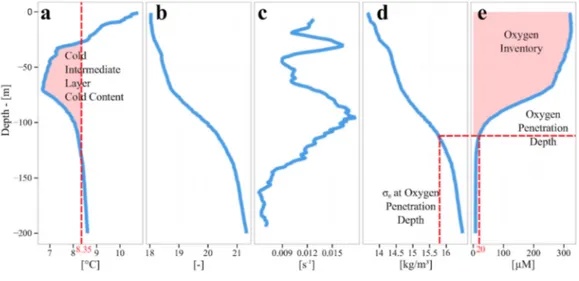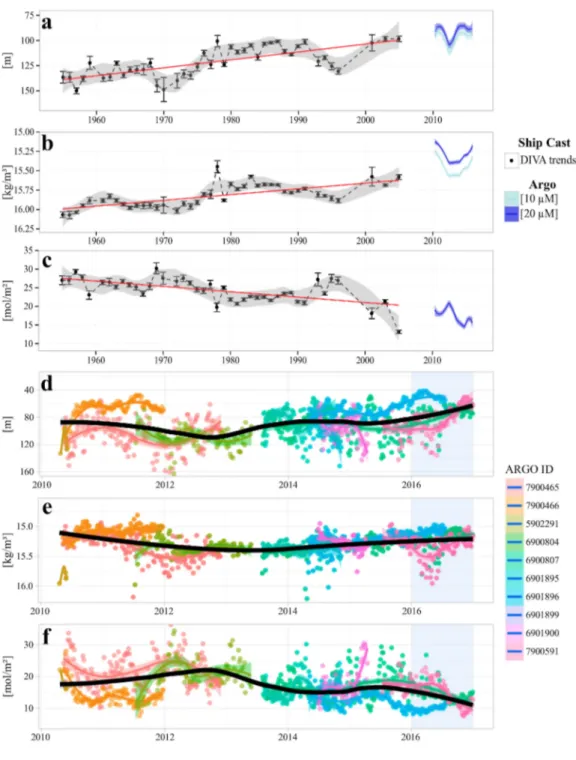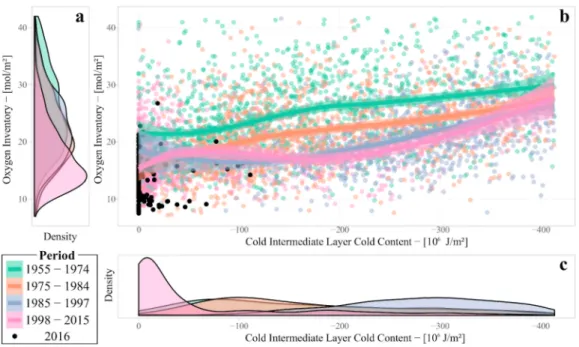Published in : Journal of Operational Oceanography (2018), vol. 11, suppl. 1, pp. s103-s106 DOI : 10.1080/1755876X.2018.1489208
Status : Postprint (Author’s version)
DECLINE OF THE BLACK SEA OXYGEN INVENTORY
Leading authors: Arthur Capet, Luc Vandenbulcke, Marilaure Grégoire. Contributing authors: Veselka Marinova.
Statement of outcome: The Black Sea is entirely anoxic except for a thin ventilated surface layer, about 10% of its volume. During the past 60 years, following a trend recently intensified by atmospheric warming, the vertical extent of this oxygenated layer has narrowed from 140 to 90 m. The three Argo profilers active for 2016, although hardly representative for a basin average, suggest an ongoing deoxygenation trend indicate an average oxygen penetration depth of 72 m.
Products used: Ref.
No. Product name & type Documentation 3.6.1 INSITU_BS_TS_REP_ OBSERVATIONS_013_042 In situ PUM: http://marine.copernicus.eu/ documents/PUM/CMEMS-INS-PUM-013.pdf QUID: http://marine.copernicus.eu/ documents/QUID/CMEMS-INS-QUID-013-042.pdf 3.6.2 INSITU_BS_NRT_ OBSERVATIONS_013_034 In situ PUM: http://marine.copernicus.eu/ documents/PUM/CMEMS-INS-PUM-013.pdf QUID: http://marine.copernicus.eu/ documents/QUID/CMEMS-INS-QUID-013-030-036.pdf The Black Sea is characterised by a strong and permanent vertical salinity gradient that is maintained by contrasting inflows of fresh water (riverine) and high salinity water (Mediterranean Sea) (Öszoy and Ünlüata 1997). This gradient stabilises the water column, and in particular prevents the ventilation, by mixing, of the deeper layers. In consequence, the permanent absence of oxygen prevents aerobic life from thriving in the Black Sea below the ventilated surface layer (Figure 3.6.1). In winter, surface cooling generates dense cold water masses along the shelf breaks. Like the dense Atlantic saline inflow on the bottom of the Baltic Sea (Section 3.7), these denseCold Intermediate Waters slip on the Black Sea halocline and ventilate the lower part of the oxygenated layer. This cold dense water formation also leaves a mark on the temperature profile, the so-called Cold Intermediate Layer (Figure 3.6.1). The variability of intermediate layer ventilation can thus be retrieved from in situ temperature profiles.
Starting from the late 1980s, several studies discussed the vertical migration of the oxycline (ie. the limit separating oxygenated water from anoxic water), in response to changes in basin-wide nutrient load and climatic variability (Murray et al. 1989; Tugrul et al. 1992; Kono-valov and Murray 2001; Capet et al. 2016). A key issue is that the Black Sea circulation entrains an important horizontal variability of depth-related properties, making it difficult to estimate temporal trends from limited data sets. This issue can be minimised using density as a vertical coordinate, and considering spatial and seasonal variability when reconstructing interannual trends of long-term in situ data sets (Capet et al. 2014).
Four diagnostics were derived from in situ profiles (Figure 3.6.1). The oxygen penetration depth is the depth at which [O2] < 20 µM. It is expressed on a depth scale (m) and on a density scale (kg/m3). The
Published in : Journal of Operational Oceanography (2018), vol. 11, suppl. 1, pp. s103-s106 DOI : 10.1080/1755876X.2018.1489208
Status : Postprint (Author’s version)
oxygen inventory is the total amount of oxygen in one column of water (mol/m2). The cold content of
the Cold Intermediate Layer is the temperature anomaly below 8.35°C, integrated vertically.
The Cold Intermediate Layer cold content is expressed in (J/m2) and indicates the intensity of dense
water formation in winter (Capet et al. 2014). The threshold of 8.35°C, used to define the Cold Intermediate Layer, was introduced and justified by Stanev et al. 2013 and has been compared with the more traditional threshold of 8°C by Capet et al. 2014.
Figure 3.6.1. Typical summer profiles of (a) temperature, (b) practical salinity, (c) Brunt-Väisälä
frequency, (d) potential density anomaly and (e) oxygen concentration illustrating the vertical structure of the central Black Sea. Red marks illustrate the diagnostics used to characterise the oxygen content and the Cold Intermediate Layer from in situ profiles (product reference 3.6.1).
Temporal trends (Figure 3.6.2) for these four diagnostics were derived from 4385 ship-based casts [1] using the DIVA detrending procedure (Capet et al. 2014). The Argo (product reference 3.6.2) time series (Jaccard et al. 2015; Schmechtig et al. 2015) indicated on Figure 3.6.2(a-c) is obtained from a smoothed average of all floats present at a given time (Figure 3.6.2(d-f)). Further details are given in Capet et al. (2016).
The long-term deoxygenation of the open Black Sea can be observed on the basis of historical oxygen profiles (1955-2005, product reference 3.6.1) and is confirmed by more recent Argo floats (2010-present product reference 3.6.1). The most striking feature of this trend is the shoaling of the oxycline depth (Figure 3.6.2(a), from 140 m (1955) to 90 m (2010-2015). Over this period, the oxygen inventory of the open Black Sea decreased by 44%.
Argo profiles collected during the year 2016 (product reference 3.6.2) depict the shallowest annual average oxygen penetration depth, since the beginning of the Argo era (72 m, Figure 3.6.2). This value should be considered with care, bearing in mind the important horizontal variability (Figure 3.6.2) and the poor spatial coverage provided by only three oxygen-recording floats. Argo profiles from 2016 show null or very low cold water content, and are amongst the smallest recorded oxygen inventories (Figure 3.6.3(a)).
Published in : Journal of Operational Oceanography (2018), vol. 11, suppl. 1, pp. s103-s106 DOI : 10.1080/1755876X.2018.1489208
Status : Postprint (Author’s version)
Figure 3.6.2. Interannual variations of oxygen penetration depth on a (a,d) depth and (b,e) density
scale and (c,f) oxygen inventory, (a, b,c) Multidecadal trends merging analysis of (black dots) ship-based casts and (blue) Argo floats. For Argo, oxygen penetration depths are also shown using a lower threshold (10 µM) to acknowledge a potential bias between Winkler and Argo oxygen records. The linear trends assessed from the ship-based data set are -0.79 m/yr, -0.0074 kg/m3/yr and -0.144 mol
O2/m2/yr for (a), (b) and (c), respectively. (d,e,f) Focus on the Argo era (2010-present) and 2016. Note
Published in : Journal of Operational Oceanography (2018), vol. 11, suppl. 1, pp. s103-s106 DOI : 10.1080/1755876X.2018.1489208
Status : Postprint (Author’s version)
Figure 3.6.3 provides elements for a mechanistic interpretation of the observed trends. It illustrates the ventilating role of the cold dense water formation by depicting the distribution of oxygen inventory, against the cold content of the Cold Intermediate Layer. The distributions obtained for the first periods (1955-1975; 1976-1985; 1986-1998) show an evolution towards low oxygen inventory for any given cold content (Figure 3.6.3(b). This suggests biogeochemical sinks and can be attributed to enhanced respiration rates following the Black Sea eutrophication phase. The later period (1999-2015) does not depict further vertical shift, in agreement with the nutrient reduction that took place in the early-1990s, but nonetheless contains the lowest cold contents (Figure 3.6.3(c) and the lowest oxygen inventories (Figure 3.6.3(a). This stresses out that atmospheric warming, by restricting dense water formation, might limit the ventilation of the Black Sea intermediate layers and lead to a further decline of the Black Sea oxygen inventory (Capet et al. 2016).
The Black Sea lacks the monitoring effort that has been developed in the Baltic Sea (cf. Section 3.8). There is an urgent need to evaluate at regional and national levels the risk and consequences of further deoxygenation, and to measure the impact of global warming by quantifying the sources and sinks of the Black Sea oxygen budget and their respective variability. In particular, large fishes are known to avoid suboxic conditions (Stramma et al. 2012). In the Black Sea, studies suggest that zooplankton migrate to remain in oxic waters (Ostrovskii and Zatsepin 2011). We therefore suggest that habitat compression may have affected the Black Sea trophic web. Yet, to our present knowledge, the possible impact of deoxygenation-related habitat compression on Black Sea fisheries has not been documented. Figure 3.6.3. Estimates of the probability density function for (a) oxygen inventory and (c) cold
content within the Cold Intermediate Layer, which is a proxy for convective dense water formation. Panel (b) highlights the ventilating role of cold water formation by depicting the relationship between cold water and oxygen content. Black dots locate the 2016 Argo profiles on this diagram.


